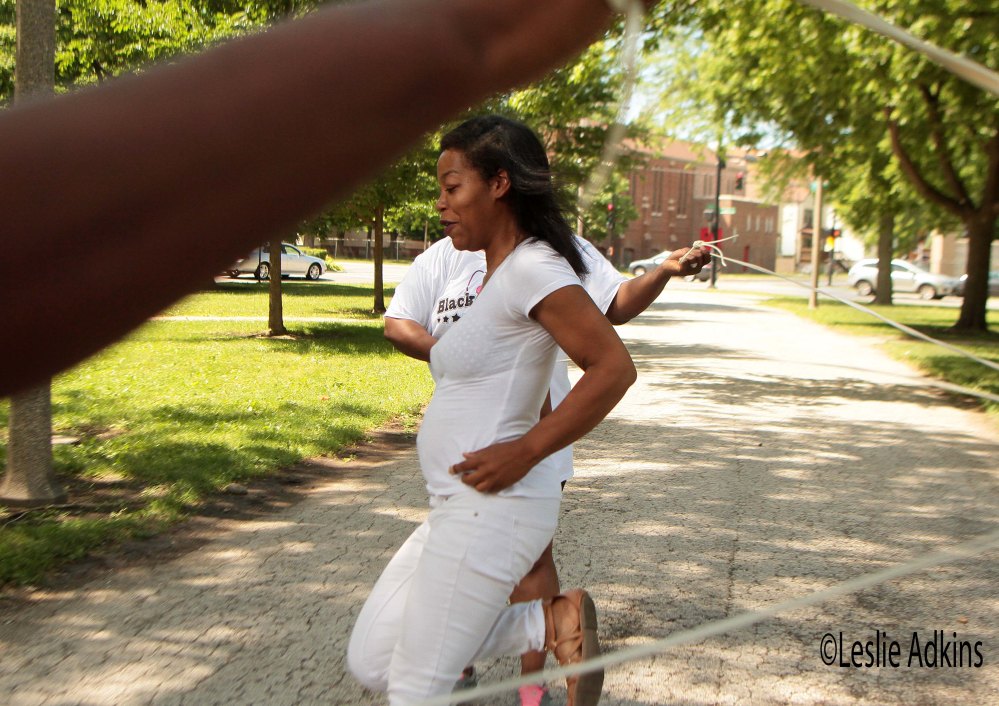Research Question 2: How do jump rope meetup group shape health and fitness perceptions and behaviors amongst participants?
Four themes emerged from my participant observation of BGJ meetup groups and interviews with attendees in regards to health and fitness perceptions and behavior.
Fitness can be fun. As a nostalgic form of physical play, participants felt jump rope was a fun way to be active. After arriving to events, participants immediately began “playing”. Social relations seemed friendly and easy. New participants became quickly familiar, calling one another by first name and conversing about a range of topics including racism, dating, public housing, hair, and graduate school. All interviewees reported feeling positive after attending BGJ meetups.

For participants, fun fitness might also mean low pressure, low commitment and informal. At Park 2, Denise openly criticized another participant’s turning skills by calling a newcomer to the group “double handed” (turning the two ropes to an inconsistent rhythm), and aggressively requested new participants continue to attend the meetup each Sunday. The new participants responded negatively to Denise’s request and did not verbally commit to weekly attendance.
Recruiting. The laid-back open environment at BGJ events seem to worked well in recruit new players in the park. At the meetup at Park 2 Rita, Denise and myself asked females walking in the park if they wanted to jump rope. In Chicago ebonics, I yelled toward two females: ‘You coming to jump? Ya’ll jumping with us?”. The females began approaching. Rita said “Ok come on” and motioned for the females to walk towards our group. While walking toward us, one female said, “I haven’t jumped rope in years”, then jumped into the ropes. The other female responded “Look at her. She’s got tricks and everything”.
All of the females we invited in the park walked over to join the jump rope game. This informal form of recruiting is reflective of childhood double dutch jump rope culture. As a child, I simply asked other children, “Do you want to play rope?”. This form of recruiting appeared highly effective in spontaneously engaging park goers in jump rope.

Social Support. Social support has been tied to enhanced health in many contexts (Israel, Checkoway, Schulz, Zimmerman, 1994, p.158). At BGJ meetup events, social support in the forms of praise, tangible assistance, and encouragement were openly expressed.
Participants praised jumpers for their skills and performances, and jumpers sometimes praise themselves. When LaShae jumped over the ropes for a long duration of time performing kicking tricks, she exclaimed, “that’s on the streets”, which meant she performed an impressive street style of double dutch.
If a jumper was not successful or did not participate they were encouraged to engage in the jump rope game, or continue trying to jump over the ropes. When a game of Salami commenced at Park 1, Chandra yelled, “I know Salami, I loved Salami!”. In Salami, a single jump rope is utilized. Turners sing a song about a sandwich while the jumper touches the group intermittently.
When I encouraged Chandra to try jumping in the ropes, Chandra commented on her weight and limited physical capabilities. I responded assuring her that she could still jump. After a few minutes of encouragement, and witnessing another jumper try the Salami game, Chandra jumped in the rope when a game of Salami commenced.
Although I encouraged Chandra, I joked with Rita about her poor jump rope skills. I yelled “Come on Rita, you ain’t doing no better since last year”.

At both jump rope meetup events, participants openly discussed their age in relation to their fitness levels. It appeared older jumpers served as encouragement for the groups. Dressed in white jeans and a white tee shirt, fitness Coach Meka was a newcomer to the group at Park 2. As we attempted to sing jump rope songs while playing, Coach Meka called out a jump rope song, and asked the group if we remembered the song. She commented the song was from the 1970s and alluded that the rest of the group maybe too young to be familiar with the jump rope song. Coach Meka mentioned she was 52 years old. The group exclaimed in awe of her mature age and good jump rope skills. Iris a long time participant, chimed into the discussion, adding that she was 51 years old. Both Coach Robin and Iris shared pride in their age and physical abilities. We also joked about the amount of grey hair we had.
Click to view a video jumping at the meetup at Park 1: https://drive.google.com/file/d/0B8Rj9lbdkyJuenZYNW5BblNkWlk/view?usp=sharing
Health/Fitness Exchange. At both meetup events, participants shared health information and their interests in other fitness activities. At Park 1, Nola, a 35 year old prolific jumper and health enthusiast known for her skills in jumping for long periods of time, explained she’d gone to Atlanta to gain certification in double dutch aerobics. Nola asked the turners to turn slowly while she demonstrated new skills in kicking while jumping. The group expressed interest in engaging in double dutch aerobics classes. Although there was less discussion about fitness at Park 2, the group did talk about diet monitoring and expressed desire to jump more frequently for weight loss.
Publicity. It seemed publicity for special events and public praise for jump rope skills was also enjoyable for participants.As Denise announced she was video recording the double dutch game at Park 2 for a social media site, Rita asked jumpers to perform for “snaps” or pictures. Denise described publicity as a positive of participating in Black Girls Jump:
“People know me from it if nothing else. People know me from the Black Girls Can Jump. Oh you the girl who can jump rope. Or people seen me on TV on the Bud Billiken parade. If nothing else it brought me a lot of publicity.”